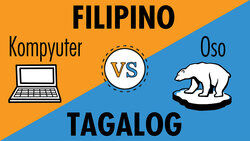
Tagalog vs. Filipino Language
When it comes to the Filipino vs Tagalog language, there is a lot of confusion. Many people even wonder if Filipino and Tagalog are the same language. To answer this question, they are not. Instead, you can think of the Filipino language as evolving from Tagalog.
So, while Filipino is related to Tagalog, as linguists will tell you, Filipino is its own language. Now that you know Filipino and Tagalog are different, let's explore their differences by looking at each one.
A Look at Tagalog
The primary language of Manila, Tagalog, meaning "river dweller," is a native language to the area and was declared the first official language of the country. Tagalog is currently written using the Latin alphabet, but at one time, it was written using the Baybayin alphabet, which is a script alphabet similar to Indian alphabets.
The alphabet itself only has 20 letters. While it is missing some letters like c and f, it does have unique letters like ng that comes between n and o. A few examples of Tagalog words include:
- araw - sun
- baboy - pig
- kabayo - horse
- daga - rat
- gulay - vegetables
- oso - bear
Filipino Language: An Evolution
Since Filipino has evolved from Tagalog, it has a lot of Tagalog roots. This means that many of the words that you encounter will come from Tagalog. So, you might be wondering how the two are different. Check out how Filipino is unique.
Filipino Alphabet
In addition to Tagalog, Filipino uses sounds and words from other Philippines languages including Cebuano and Kapampangan, to name a few. It also uses words and phonics from foreign languages like Spanish, English, Sanskrit, Chinese, Arabic, and Malay.
Some of these words can't be handled by the 20 letter alphabet of the Tagalog language. Therefore, Filipino has 28 letters in its alphabet including z, x, c, j, and k.
Here are a few examples of Filipino words.
- drayber - driver
- kompyuter - computer
- kumusta - hello
- salamat - thank you
- sarap - delicious
- kuya - big brother
History of Philippines Language
In 1937, Tagalog was the official language of the Philippines; however, this was changed to Filipino in 1987. Not only did Tagalog have some words that were considered "aesthetically unpleasing," but Cebuano speakers contested Tagalog as the official language. Therefore, Filipino was created as an upgraded version of Tagalog to make it more aesthetically pleasing for President Ferdinand Marcos's efforts in creating a new society.
However, Tagalog is still spoken by 20 million Filipinos in the Philippines. Since the languages are so close to one another, those that speak Filipino are typically not differentiated from Tagalog.
The Languages of the Philippines
While Filipino and Tagalog are the two major languages that you hear of and cause the most confusion, there are other important languages of the Philippines including Cebuano, Waray, Hiligaynon, Kapampangan, and more. In total, there are about 140 different languages derived from mostly Malayo-Polynesian roots. Your head might be spinning, but once you consider the number of islands within the Philippines, it makes sense.
Philippines Languages
The reason that it is so hard to figure out the difference between the Tagalog vs. Filipino language is because Filipino based on the Tagalog language. You can think of Tagalog as the root language for Filipino. Interested in learning more about Filipino? Then you might want to give Filipino idioms a try. You never know when they might come in handy.